2011 Ford Explorer – Click above for high-res image gallery
For part two of our in-depth look at the 2011 Ford Explorer, we'll take a look at its new powertrains and improvements in fuel efficiency, as well as how well it can still tow a trailer. But first let's see what kind of techno-goodies Ford has applied to this new SUV.
Technology
This being 2010, technology has to play a big part in any major new vehicle introduction. On the inside, the Explorer joins the new Edge, Focus and Lincoln MKX in adopting the MyFord Touch interface. We first saw this new touch sensitive interface when the MKX and Focus were unveiled at the 2010 Detroit Auto Show in January. Much like modern smartphones, the center stack has a smooth surface with capacitive touch buttons to manage the audio and climate controls. Continue reading after the jump or check out part one of our introduction to the 2011 Ford Explorer first.
The MyFord Touch system will be standard on up-level XLT and Limited Explorers. The base Explorer comes equipped with a non-touch version dubbed simply MyFord. The non-touch version has an instrument cluster with a single 4.3-inch LCD display alongside the analog speedometer and a second non-touch 4.3-inch display in the center stack. Buyers can then add Sync along with that popular technology's newly improved voice recognition capabilities.
MyFord Touch upgrades the instrument cluster to the same dual 4.3-inch display system that debuted last year in the Fusion Hybrid as SmartGauge. The center stack display is also replaced by an eight-inch touch screen. MyFord Touch also adds several data inputs including two USB ports and an SD flash card slot. With most phones and other portable electronics now able to charge via USB, having two ports will allow charging of a phone and the use of an iPod at the same time.
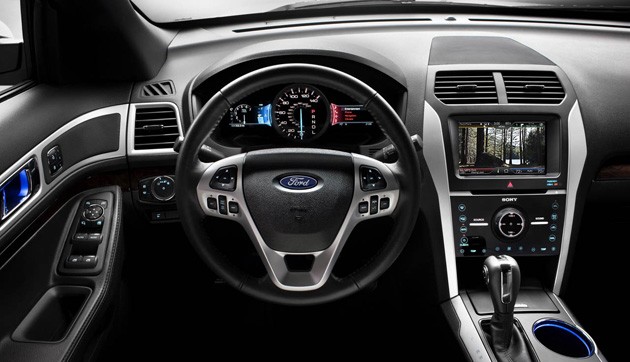
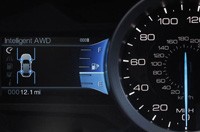
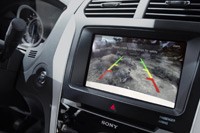
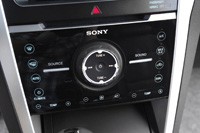
One of the big complaints about manufacturer integrated satellite navigation systems has been their high cost, typically around $2,000. Because Sync now includes an integrated GPS receiver and MyFord Touch has the display, Explorer (and Edge and MKX) drivers will be able to add map-based navigation for just $795. The map data will actually be supplied on an SD card to be inserted in the supplied slot. Of course, if you are starting from the base Explorer and you add the $1,000 MyFord Touch option plus $795 for the map data on the flash card, you're back to nearly that originally two grand price tag.
Those who don't want to pay extra for map-based navigation can also use the new downloadable traffic, directions and information (TDI) system. We got a demonstration of the system's ability to download Google Maps at the preview of the Explorer. Ford owners register their cell phone(s) with the SyncMyRide website, then find a destination in Google maps (and later this year, Mapquest), click on it and send it to their phone number. Once the phone connects in the car, drivers can use Sync to download the directions. Turn-by-turn directions will then be displayed in the instrument cluster.
As part of its attempt to set the Explorer apart from its crossover siblings, Ford has also added a new terrain management system. When talking to previous Explorer owners, Ford found that most didn't understand when and how to use the four-wheel-drive low, high and automatic settings. Since the Explorer is meant to be an SUV with real off-road capability, engineers came up with a system that manages the throttle response, transmission shift points and torque distribution management based on the driver selecting the conditions. A control knob on the center console allows the driver to choose from the default normal mode, as well as mud, snow, sand and hill-descent control modes.

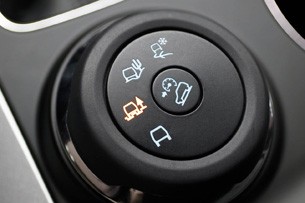
In normal mode, the default is to send all of the drive torque to the front wheels and then redirect torque to the rears based on wheel slip. In mud mode, more of the torque is directed to the rear axle, and the transmission shift points are moved up to allow for higher engine speeds, which along with more allowed wheel slip, helps to throw mud off the tires. Sand mode takes this a step further with even higher shift points and dialing back the traction control.
The snow mode goes the opposite direction with less slip and lower shift points to help ensure vehicle stability in winter weather conditions. Finally, the hill descent control automatically manages the vehicle speed when going down steep grades so that the driver can focus on maneuvering the vehicle without having to manipulate the pedals.
Powertrain
The biggest news ahead of the 2011 Explorer's launch has been its expected fuel economy improvement. The 2011 Explorer will initially have two engines available, a normally aspirated 3.5-liter V6 and the new 2.0-liter EcoBoost inline-four. Each of the engines are expected to provide a 30-percent boost in mileage over the Explorer's outgoing 4.6-liter V8 and 4.0-liter V6.
The previously mentioned 2008 concept coincided with the original announcement of the gasoline-turbocharged-direct-injected (GTDI) EcoBoost engines and the concept was said to be powered by a 2.0-liter engine. The production 2.0-liter actually debuted earlier this year in the European Mondeo and S-Max with 203 horsepower, while a more powerful 237-hp version was just recently announced.
For the Explorer, Ford is currently quoting the same 237 hp, although officials tell us that the version used in the Explorer and Edge will have different calibrations from the Euro edition, at least in part to meet U.S. emissions standards. Despite its small displacement, the four produces 27 hp more than the prior Explorer's ancient 4.0-liter V6.
The V6 will actually be the standard engine and the higher mileage turbo-four will be optional.
The really important characteristic of these downsized engines is the torque that's made possible by turbocharging and direct injection. The charge cooling effect of the direct injection allows Ford to run 16 psi of boost, which helps the 2.0-liter engine generate 250 pound-feet of torque from 1,750-4,000 rpm. The old 4.0-liter peaked with 254 lb-ft at 3,700 rpm, but didn't have the flat torque curve of the new smaller engine.
It will be several months before we know for sure if this is enough engine for a 4,500-pound SUV. However, based on our experiences with Ford's 3.5-liter EcoBoost V6 and other similar turbocharged four-cylinder engines, it will likely do just fine and should achieve EPA mileage numbers of at least 18 mpg city and 26-27 mpg highway.
The 2011 Explorer's other available engine is the 3.5-liter V6 which we've come to know and admire in other Ford vehicles over the last several years. For this new application, it retains its port fuel injection system but output has been bumped from 262 hp in the Flex to 290 hp with torque up from 248 lb-ft to 255. That's only 2 hp shy of the old V8 but a deficit of 60 lb-ft. Ford is projecting that the V6 will get 20 percent better fuel efficiency than the old V6 and 30 percent better than the V8. Like other new Fords, both engines are paired with a six-speed automatic transmission. For those who want to manually control gear selection, an up-down switch is mounted on the side of the shift knob.
You might expect that the four-cylinder EcoBoost would be the 2011 Explorer's base engine with the V6 optional, but you'd be wrong. The V6 will actually be the standard engine and the higher mileage turbo-four will be optional. The hope is that customers will be willing to pay extra for more fuel efficiency. Ford still isn't talking pricing yet, but hopefully the EcoBoost option will only be a few hundred dollars at most.
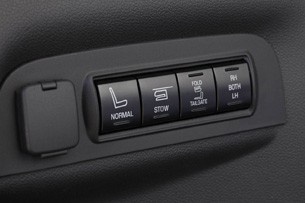
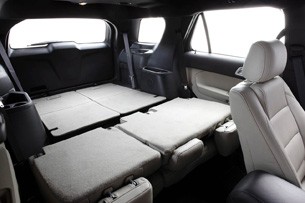
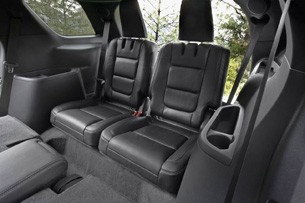
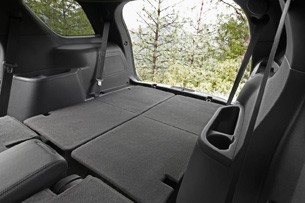
With fuel economy and capability being the two primary factors in which customers are interested, Ford appears to have hit the target on the first and mostly hit the latter. We say mostly because there is one specification where the 2011 Explorer falls short of its predecessor: towing. The old V8 Explorer could tow a 7,000-pound trailer while the old V6 ranged from 5,100-5,300 pounds depending on the configuration.
The 2011 Explorer with its base V6 now has only a 5,000-pound towing capacity, beating the Flex by 500 pounds but falling short of the Chevrolet Traverse by 200 pounds. A couple hundred pounds probably won't matter much to most customers, but the 2,000-pound drop compared to the old V8 could be a deal breaker for some. People who need 7,000 pounds or more will have to step up to a full-size SUV or pickup from Ford, or look elsewhere, such as at the diesel-powered German SUVs from Volkswagen, Audi, Mercedes-Benz and BMW.
The real towing deficit comes with the 2.0-liter EcoBoost engine, which is limited to a mere 2,000 pounds. With the torque available from the turbo-four, we would have thought it could handle more than one ton on its trailer hitch. The difference is likely due to the fact that the EcoBoost engine is only available with front-wheel drive, while the V6 is offered with either front- or all-wheel drive. The four-cylinder Explorer is clearly only for those who need go-anywhere capability without a trailer.
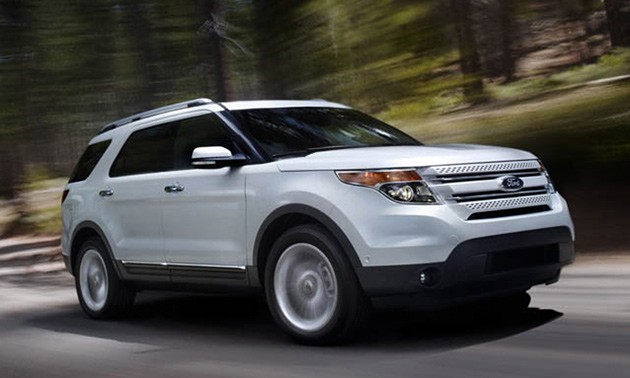
When Ford first announced EcoBoost, Derrick Kuzak talked about engine downsizing as part of a holistic approach to improving fuel efficiency. In conjunction with smaller engines, the amount of structure required to support the powertrain can be reduced, leading to lower vehicle mass. This leads to lower mass brakes and suspension, which then comes back around to reducing the powertrain requirements. Hyundai clearly demonstrated this by limiting its new Sonata to four cylinder engines only and thus reducing the weight of the car by over 100 pounds.
Similarly, despite the increased size and drastically increased equipment on the Explorer, Ford has managed to cut the weight of the V6 model by about 100 pounds compared to the old V8 model. Other positive changes include the structure now containing twice as much high-strength boron steel as well as an aluminum hood.
At this point it's too early to tell how capable the Explorer really is as an SUV and whether or not the engineers have succeeded in their goal of reinventing it. Certainly Jeep has demonstrated that a unibody structure is no detriment to off-road ability, and the Grand Cherokee can tow over 7,000 pounds. Based on its heritage with the Flex/Taurus platform, we expect the Explorer's on-road dynamics to be among the best in its class. The 2011 Explorer will be available in November and we'll make certain to get behind the wheel before then to determine if it's really any good at all the other stuff that makes an SUV what it is.
Check out part one of our introduction to the 2011 Ford Explorer.
MAJOR SUV FUEL ECONOMY GAINS, TECHNOLOGY, STYLE HIGHLIGHT REINVENTION OF FORD EXPLORER
• Ford reinvents the Explorer SUV with best-in-class fuel economy, improved driving dynamics and terrain management system – all wrapped in a modern, weight-saving design
• Explorer raises the bar on safety with a class-leading array of airbags including industry-first inflatable rear seat belts, Trinity front impact structure, AdvanceTrac® with RSC® (Roll Stability Control™) and Curve Control functionality
• Explorer features MyFord Touch™ driver connect technology and SYNC® integrated communications and entertainment system to help keep a driver's eyes on the road and hands on the wheel. Explorer offers more technology than in-class competitors, rivaling content found in premium SUVs
DEARBORN, Mich., July 26, 2010 – Ford Explorer – the vehicle that defined a segment – has been completely reinvented, raising customers' expectations of sport utility vehicle (SUV) fuel efficiency, safety, technology, capability and quality.
"The all-new Explorer will deliver today's SUV buyers the attributes they really want and value, and a few they might not even have dreamed of," said Mark Fields, Ford president of The Americas. "We're proud to introduce the new Explorer to customers and fans around the world today and pleased to begin a whole new era that blends strong SUV fuel economy and performance."
The all-new Explorer launches today to its Facebook friends in a unique social media initiative, followed by reveal events throughout the U.S. and Canada.
Shattering SUV fuel economy and performance expectations
"The new Explorer simply does everything well," said Derrick Kuzak, group vice president, Global Product Development. "It raises the bar for ride and handling on the road and transforms the off-road experience. It's the hands-down winner for towing capability and ease. All this capability – and three rows of seating – with amazing fuel economy will make Explorer the absolute right choice for families with a sense of adventure."
The 2011 Explorer with V6 power is expected to deliver more than 20 percent better fuel economy than the 2010 model, shattering conventional expectations for SUV fuel efficiency. When equipped with the available 2.0-liter EcoBoost™ I-4 engine, Explorer fuel economy is expected to improve by more than 30 percent and exceed the 2010 Honda Pilot and 2010 Toyota Highlander V6.
Chief Nameplate Engineer Jim Holland said the team targeted two key objectives when developing the 2011 Ford Explorer.
"It had to look modern and contemporary – inside and out – yet be instantly recognizable as an Explorer," said Holland. "Next, the new Explorer needed to deliver the fuel economy today's customers want, combined with the performance, capability and empowerment they expect from an SUV."
Driven by the commitment to give customers unsurpassed fuel efficiency with each new vehicle, Ford attacked every detail to transform Explorer with significantly improved fuel economy:
• Twin independent variable camshaft timing (Ti-VCT)
• Latest Ford EcoBoost engine
• Six-speed automatic transmissions
• Electric power-assisted steering (EPAS) to significantly reduce parasitic power loss
• Intelligent four-wheel drive (4WD)
• Variable-displacement air-conditioning compressor
• Optimized tires for reduced rolling resistance
• Slippery aerodynamics with harmonized front air dam and rear liftgate spoiler
Weight reduction is a key element in improving Explorer fuel efficiency. While adding significant content to the vehicle, engineers were able to reduce total vehicle weight by almost 100 pounds through the use of lighter materials such as an aluminum hood. Explorer weight loss is even more impressive, as the latest versions of Honda Pilot and Toyota 4Runner have added pounds versus previous models.
Explorer's available advanced 2.0-liter EcoBoost I-4 delivers the power of a normally aspirated V6 without compromising four-cylinder fuel economy. Aimed at the SUV buyer whose top priority is fuel economy, this turbocharged and intercooled I-4 engine delivers a projected 237 horsepower at 5,500 rpm and 250 lb.-ft. of torque from 1,700 through 4,000 rpm. The EcoBoost employs direct injection of gasoline, Ti-VCT, direct-acting mechanical bucket (DAMB) valve lifters and four valves per cylinder.
Explorer's standard powertrain combines front-wheel drive with a 3.5-liter Ti-VCT V6 engine, delivering an estimated 290 horsepower and 255 lb.-ft. of torque. Ti-VCT allows individually optimized camshaft timing of valve opening and closing events to improve mechanical efficiency while delivering increased power and reducing part-throttle emissions. Mated to a six-speed automatic transmission, this powerful, flexible and efficient V6 is projected to deliver more than 20 percent better fuel economy versus the previous Explorer V6 model.
Explorer's variable-displacement air-conditioning compressor provides a fuel economy benefit with less drag and smoother transition for improved driveability.
Each Explorer engine is paired with a unique six-speed automatic transmission, combining lowered initial gears for improved off-the-line acceleration and higher gearing for improved efficiency at lower engine rpm when cruising.
Explorer V6 models are available with an intelligent 4WD system that adds terrain management. Situation-selectable, this powertrain advancement takes the guesswork out of 4WD range choice.
A driver need only turn the console-mounted knob to the proper setting among snow, sand, mud and normal modes. This system also includes a hill descent mode.
Simpler and more convenient for SUV veterans, the system will be a confidence-builder for drivers new to the segment.
Contemporary design with segment-leading craftsmanship and quietness
In addition to its clean, modern design inside and out, Explorer aims to please SUV shoppers with a thoughtful, flexible interior package that abounds with clever storage capacity. The new SUV features more head and shoulder room, three rows of flexible seating, and room for everything families want to take along on their adventures.
The Explorer design – inside and out – is executed with world-class craftsmanship. Tight margin gaps are just one indication of the immense attention to detail applied to craftsmanship across the spectrum, from design to engineering to manufacturing.
The Chicago facility where Explorer will be produced raised the bar on initial quality measures with the recent Taurus launch, which is good news for customers.
"Crafting a high-quality vehicle is like preparing a gourmet meal," said Peter Bejin, craftsmanship supervisor. "You start with high-quality ingredients, execute your recipe with flawless preparation and finally, present it with flair and panache."
Quietness – another profound advancement in the all-new 2011 Ford Explorer – also will signal quality to customers.
The team enhanced noise, vibration and harshness (NVH) control for the all-new Explorer using an advanced technology called NoiseVision. A ball with hundreds of tiny cameras and microphones, NoiseVision allows engineers to pinpoint and address potential noise issues earlier in the development process.
Explorer is expected to be superior to in-segment competitors and rival premium SUVs in quietness and NVH control.
Explorer safety – strength, technology and innovation
The all-new Explorer targets top safety ratings with a stiff unibody structure and a class-leading suite of active and passive safety features and technologies, plus another Ford safety innovation – the world's first second-row inflatable rear belts.
Rear seat passengers – often children or mature passengers – can be more vulnerable to head, chest and neck injuries. Ford's unique inflatable rear belts spread impact forces across more than five times the area than conventional seat belts, reducing pressure on the chest while helping to control head and neck motion. Belt comfort should also help increase usage rates. Studies show inflatable belts to be more comfortable for passengers due to padding.
From the boron front bumper beam through the hydroformed front frame rails and high-strength steel side-impact tubes, Explorer's rigid body structure is designed to provide robust protection for occupants. In the instance of a crash, these elements come together to protect Explorer driver and passengers inside a safety cage of strength.
Standard Explorer safety features include:
• AdvanceTrac with RSC features Curve Control functionality to provide braking – optimized by each individual wheel
• Second-generation first-row airbags, side seat airbags
• Belt-Minder® for driver and first-row passenger
• Front passenger sensing system
• Energy-management system pretensioning for height-adjustable first-row seat belts
• LATCH (Lower Anchors and Tethers for CHildren) system for outboard second-row positions, for safely securing child safety seats
• SOS Post-Crash Alert System™
• Safety Canopy® side curtain airbags
• Tire Pressure Monitoring System
Available Explorer safety features include:
• Adaptive cruise control and collision warning with brake support
• BLIS® (Blind Spot Information System) with cross-traffic alert
Stretching the breadth of capability
The 2011 Ford Explorer redefines customer expectations for driving dynamics and comfort – on any road, anytime, anywhere – while stretching the breadth of SUV capability. Transforming Explorer's driving quality was central to creating an SUV for 21st century customers.
"Our objectives for Explorer dynamics were threefold," said Carl Widmann, vehicle engineering manager. "The first element was to greatly increase on-road comfort, capability and driving dynamics. The second was to maintain the 'any road, anytime, anywhere' capability of the previous model. Finally, we aimed to apply technology to the task of safely towing, as V6 Explorer models are rated up to 5,000 pounds. We think customers will be pleased with the
next-generation Explorer on all three counts."
The theme of the all-new Explorer dynamics development was balance. The team sought to provide an engaging driver experience in harmony with the extended breadth of 4WD capability to build driver confidence.
The shift to a unibody construction platform enabled a reduction in road noise and significantly decreased Explorer body roll in dynamic cornering situations. Independent front suspension is of the short- and long-arm configuration with a 32-millimeter front stabilizer bar. Independent rear suspension is the SR1 configuration, so-named for its one-to-one shock absorber ratio, which enables precise ride control.
Explorer's EPAS system allows for variable rates of assistance based on speed, turn-in and direction. In addition to optimized steering feel, tight on-centering and appropriate resistance, EPAS provides a fuel economy benefit in comparison to traditional hydraulic power assist systems. EPAS also enables a competitive turning radius for optimum maneuverability in parking situations, combined with increased assistance at low speeds for parking ease.
EPAS allows for the addition of Curve Control, a new feature that senses when a driver enters a turn too quickly and applies brake pressure to stabilize the vehicle.
In addition, EPAS enables the optional active park assist technology. When activated, the system scans for a suitable spot, calculates the trajectory, and steers the vehicle. The driver continues to control brake and throttle inputs, but the system steers the vehicle throughout the parking maneuver.
Off-roading standout on a variety of surfaces
The key to Explorer 4WD capability is Ford's new terrain management system.
Replacing the traditional SUV transfer case configuration, the new system takes the guesswork out of maximizing 4WD and the capabilities it enables. Rather than employment of four-high, four-low and auto settings, Explorer terrain management is selectable by situation. The four settings – available by shift-on-the-fly – include normal, mud, sand and snow.
Each setting provides unique engine behavior, throttle tip-in, transmission shift scheduling and calibrations for traction and stability control systems. Terrain management also includes Hill Descent Control™, which provides engine braking to increase driver confidence and control when descending a steep incline.
Explorer models with V6 power are rated to tow a maximum of 5,000 pounds. To aid with hookup – especially when alone – a reverse camera with zoom-in functionality is available, allowing a driver to back up to the trailer on-center. The Explorer towing package includes trailer sway control – a stability package shared with the Ford F-150 pickup – to help minimize trailer sway. Trailer brake controller wiring is also included, as is a tow/haul mode. Engaging tow/haul mode increases engine braking to help slow the vehicle and trailer when descending steep grades.
Loaded with features, convenience and connectivity
The all-new Explorer is available in three trim series levels – base, XLT and Limited. Each offering presents a robust array of standard features, with a class-leading selection of additional convenience and connectivity options so a buyer can tailor a new Explorer to his or her individual needs and desires.
Standard convenience features include:
• MyFord driver connect technology including 4.2-inch LCD screen
• MyKey™ owner control feature
• Air filtration system
• Media hub
• Easy Fuel® capless fuel filler system
• Cruise control
• Power windows, with one-touch down for driver
• Power door locks with child safety rear door locks
• Tilt/telescoping steering column
• Four 12-volt power points
• Cargo hooks
Explorer XLT includes standard content and adds:
• Automatic headlamps
• Six-speed SelectShift Automatic™
• Heated sideview mirrors with LED signal indicators and security approach lamps
• SecuriCode™ keyless entry keypad
• Reverse sensing system
• Perimeter alarm
Explorer Limited includes all base and XLT content, plus:
• PowerFold® sideview mirrors with driver's side memory
• Ambient lighting
• Adjustable pedals with memory functionality
• Cargo net
• Dual-zone electronic temperature control
• 10-way power driver's seat, with power recline and lumbar
• Electrochromic interior mirror
• Rear view camera
• Remote start system
• 110-volt outlet
• MyFord Touch driver connect technology
• Intelligent Access with push-button start
• Universal garage door opener
"We spent our time listening to customers and addressing their needs to launch an SUV that reinvigorates the Explorer nameplate and delivers on Ford's promise of high-quality, fuel-efficient and technologically advanced vehicles with industry-leading safety," said Holland. "The all-new Explorer will change market perceptions about SUV style, fuel efficiency, technology and user-friendliness."
The 2011 Explorer will be assembled at Ford's Chicago manufacturing facility. Production begins late this year, and Explorer will be available in dealerships this winter.
About Ford Motor Company
Ford Motor Company, a global automotive industry leader based in Dearborn, Mich., manufactures or distributes automobiles across six continents. With about 176,000 employees and about 80 plants worldwide, the company's automotive brands include Ford, Lincoln and Mercury, production of which has been announced by the company to be ending in the fourth quarter of 2010, and, until its sale, Volvo. The company provides financial services through Ford Motor Credit Company. For more information regarding Ford's products, please visit www.ford.com.
• Ford reinvents the Explorer SUV with best-in-class fuel economy, improved driving dynamics and terrain management system – all wrapped in a modern, weight-saving design
• Explorer raises the bar on safety with a class-leading array of airbags including industry-first inflatable rear seat belts, Trinity front impact structure, AdvanceTrac® with RSC® (Roll Stability Control™) and Curve Control functionality
• Explorer features MyFord Touch™ driver connect technology and SYNC® integrated communications and entertainment system to help keep a driver's eyes on the road and hands on the wheel. Explorer offers more technology than in-class competitors, rivaling content found in premium SUVs
DEARBORN, Mich., July 26, 2010 – Ford Explorer – the vehicle that defined a segment – has been completely reinvented, raising customers' expectations of sport utility vehicle (SUV) fuel efficiency, safety, technology, capability and quality.
"The all-new Explorer will deliver today's SUV buyers the attributes they really want and value, and a few they might not even have dreamed of," said Mark Fields, Ford president of The Americas. "We're proud to introduce the new Explorer to customers and fans around the world today and pleased to begin a whole new era that blends strong SUV fuel economy and performance."
The all-new Explorer launches today to its Facebook friends in a unique social media initiative, followed by reveal events throughout the U.S. and Canada.
Shattering SUV fuel economy and performance expectations
"The new Explorer simply does everything well," said Derrick Kuzak, group vice president, Global Product Development. "It raises the bar for ride and handling on the road and transforms the off-road experience. It's the hands-down winner for towing capability and ease. All this capability – and three rows of seating – with amazing fuel economy will make Explorer the absolute right choice for families with a sense of adventure."
The 2011 Explorer with V6 power is expected to deliver more than 20 percent better fuel economy than the 2010 model, shattering conventional expectations for SUV fuel efficiency. When equipped with the available 2.0-liter EcoBoost™ I-4 engine, Explorer fuel economy is expected to improve by more than 30 percent and exceed the 2010 Honda Pilot and 2010 Toyota Highlander V6.
Chief Nameplate Engineer Jim Holland said the team targeted two key objectives when developing the 2011 Ford Explorer.
"It had to look modern and contemporary – inside and out – yet be instantly recognizable as an Explorer," said Holland. "Next, the new Explorer needed to deliver the fuel economy today's customers want, combined with the performance, capability and empowerment they expect from an SUV."
Driven by the commitment to give customers unsurpassed fuel efficiency with each new vehicle, Ford attacked every detail to transform Explorer with significantly improved fuel economy:
• Twin independent variable camshaft timing (Ti-VCT)
• Latest Ford EcoBoost engine
• Six-speed automatic transmissions
• Electric power-assisted steering (EPAS) to significantly reduce parasitic power loss
• Intelligent four-wheel drive (4WD)
• Variable-displacement air-conditioning compressor
• Optimized tires for reduced rolling resistance
• Slippery aerodynamics with harmonized front air dam and rear liftgate spoiler
Weight reduction is a key element in improving Explorer fuel efficiency. While adding significant content to the vehicle, engineers were able to reduce total vehicle weight by almost 100 pounds through the use of lighter materials such as an aluminum hood. Explorer weight loss is even more impressive, as the latest versions of Honda Pilot and Toyota 4Runner have added pounds versus previous models.
Explorer's available advanced 2.0-liter EcoBoost I-4 delivers the power of a normally aspirated V6 without compromising four-cylinder fuel economy. Aimed at the SUV buyer whose top priority is fuel economy, this turbocharged and intercooled I-4 engine delivers a projected 237 horsepower at 5,500 rpm and 250 lb.-ft. of torque from 1,700 through 4,000 rpm. The EcoBoost employs direct injection of gasoline, Ti-VCT, direct-acting mechanical bucket (DAMB) valve lifters and four valves per cylinder.
Explorer's standard powertrain combines front-wheel drive with a 3.5-liter Ti-VCT V6 engine, delivering an estimated 290 horsepower and 255 lb.-ft. of torque. Ti-VCT allows individually optimized camshaft timing of valve opening and closing events to improve mechanical efficiency while delivering increased power and reducing part-throttle emissions. Mated to a six-speed automatic transmission, this powerful, flexible and efficient V6 is projected to deliver more than 20 percent better fuel economy versus the previous Explorer V6 model.
Explorer's variable-displacement air-conditioning compressor provides a fuel economy benefit with less drag and smoother transition for improved driveability.
Each Explorer engine is paired with a unique six-speed automatic transmission, combining lowered initial gears for improved off-the-line acceleration and higher gearing for improved efficiency at lower engine rpm when cruising.
Explorer V6 models are available with an intelligent 4WD system that adds terrain management. Situation-selectable, this powertrain advancement takes the guesswork out of 4WD range choice.
A driver need only turn the console-mounted knob to the proper setting among snow, sand, mud and normal modes. This system also includes a hill descent mode.
Simpler and more convenient for SUV veterans, the system will be a confidence-builder for drivers new to the segment.
Contemporary design with segment-leading craftsmanship and quietness
In addition to its clean, modern design inside and out, Explorer aims to please SUV shoppers with a thoughtful, flexible interior package that abounds with clever storage capacity. The new SUV features more head and shoulder room, three rows of flexible seating, and room for everything families want to take along on their adventures.
The Explorer design – inside and out – is executed with world-class craftsmanship. Tight margin gaps are just one indication of the immense attention to detail applied to craftsmanship across the spectrum, from design to engineering to manufacturing.
The Chicago facility where Explorer will be produced raised the bar on initial quality measures with the recent Taurus launch, which is good news for customers.
"Crafting a high-quality vehicle is like preparing a gourmet meal," said Peter Bejin, craftsmanship supervisor. "You start with high-quality ingredients, execute your recipe with flawless preparation and finally, present it with flair and panache."
Quietness – another profound advancement in the all-new 2011 Ford Explorer – also will signal quality to customers.
The team enhanced noise, vibration and harshness (NVH) control for the all-new Explorer using an advanced technology called NoiseVision. A ball with hundreds of tiny cameras and microphones, NoiseVision allows engineers to pinpoint and address potential noise issues earlier in the development process.
Explorer is expected to be superior to in-segment competitors and rival premium SUVs in quietness and NVH control.
Explorer safety – strength, technology and innovation
The all-new Explorer targets top safety ratings with a stiff unibody structure and a class-leading suite of active and passive safety features and technologies, plus another Ford safety innovation – the world's first second-row inflatable rear belts.
Rear seat passengers – often children or mature passengers – can be more vulnerable to head, chest and neck injuries. Ford's unique inflatable rear belts spread impact forces across more than five times the area than conventional seat belts, reducing pressure on the chest while helping to control head and neck motion. Belt comfort should also help increase usage rates. Studies show inflatable belts to be more comfortable for passengers due to padding.
From the boron front bumper beam through the hydroformed front frame rails and high-strength steel side-impact tubes, Explorer's rigid body structure is designed to provide robust protection for occupants. In the instance of a crash, these elements come together to protect Explorer driver and passengers inside a safety cage of strength.
Standard Explorer safety features include:
• AdvanceTrac with RSC features Curve Control functionality to provide braking – optimized by each individual wheel
• Second-generation first-row airbags, side seat airbags
• Belt-Minder® for driver and first-row passenger
• Front passenger sensing system
• Energy-management system pretensioning for height-adjustable first-row seat belts
• LATCH (Lower Anchors and Tethers for CHildren) system for outboard second-row positions, for safely securing child safety seats
• SOS Post-Crash Alert System™
• Safety Canopy® side curtain airbags
• Tire Pressure Monitoring System
Available Explorer safety features include:
• Adaptive cruise control and collision warning with brake support
• BLIS® (Blind Spot Information System) with cross-traffic alert
Stretching the breadth of capability
The 2011 Ford Explorer redefines customer expectations for driving dynamics and comfort – on any road, anytime, anywhere – while stretching the breadth of SUV capability. Transforming Explorer's driving quality was central to creating an SUV for 21st century customers.
"Our objectives for Explorer dynamics were threefold," said Carl Widmann, vehicle engineering manager. "The first element was to greatly increase on-road comfort, capability and driving dynamics. The second was to maintain the 'any road, anytime, anywhere' capability of the previous model. Finally, we aimed to apply technology to the task of safely towing, as V6 Explorer models are rated up to 5,000 pounds. We think customers will be pleased with the
next-generation Explorer on all three counts."
The theme of the all-new Explorer dynamics development was balance. The team sought to provide an engaging driver experience in harmony with the extended breadth of 4WD capability to build driver confidence.
The shift to a unibody construction platform enabled a reduction in road noise and significantly decreased Explorer body roll in dynamic cornering situations. Independent front suspension is of the short- and long-arm configuration with a 32-millimeter front stabilizer bar. Independent rear suspension is the SR1 configuration, so-named for its one-to-one shock absorber ratio, which enables precise ride control.
Explorer's EPAS system allows for variable rates of assistance based on speed, turn-in and direction. In addition to optimized steering feel, tight on-centering and appropriate resistance, EPAS provides a fuel economy benefit in comparison to traditional hydraulic power assist systems. EPAS also enables a competitive turning radius for optimum maneuverability in parking situations, combined with increased assistance at low speeds for parking ease.
EPAS allows for the addition of Curve Control, a new feature that senses when a driver enters a turn too quickly and applies brake pressure to stabilize the vehicle.
In addition, EPAS enables the optional active park assist technology. When activated, the system scans for a suitable spot, calculates the trajectory, and steers the vehicle. The driver continues to control brake and throttle inputs, but the system steers the vehicle throughout the parking maneuver.
Off-roading standout on a variety of surfaces
The key to Explorer 4WD capability is Ford's new terrain management system.
Replacing the traditional SUV transfer case configuration, the new system takes the guesswork out of maximizing 4WD and the capabilities it enables. Rather than employment of four-high, four-low and auto settings, Explorer terrain management is selectable by situation. The four settings – available by shift-on-the-fly – include normal, mud, sand and snow.
Each setting provides unique engine behavior, throttle tip-in, transmission shift scheduling and calibrations for traction and stability control systems. Terrain management also includes Hill Descent Control™, which provides engine braking to increase driver confidence and control when descending a steep incline.
Explorer models with V6 power are rated to tow a maximum of 5,000 pounds. To aid with hookup – especially when alone – a reverse camera with zoom-in functionality is available, allowing a driver to back up to the trailer on-center. The Explorer towing package includes trailer sway control – a stability package shared with the Ford F-150 pickup – to help minimize trailer sway. Trailer brake controller wiring is also included, as is a tow/haul mode. Engaging tow/haul mode increases engine braking to help slow the vehicle and trailer when descending steep grades.
Loaded with features, convenience and connectivity
The all-new Explorer is available in three trim series levels – base, XLT and Limited. Each offering presents a robust array of standard features, with a class-leading selection of additional convenience and connectivity options so a buyer can tailor a new Explorer to his or her individual needs and desires.
Standard convenience features include:
• MyFord driver connect technology including 4.2-inch LCD screen
• MyKey™ owner control feature
• Air filtration system
• Media hub
• Easy Fuel® capless fuel filler system
• Cruise control
• Power windows, with one-touch down for driver
• Power door locks with child safety rear door locks
• Tilt/telescoping steering column
• Four 12-volt power points
• Cargo hooks
Explorer XLT includes standard content and adds:
• Automatic headlamps
• Six-speed SelectShift Automatic™
• Heated sideview mirrors with LED signal indicators and security approach lamps
• SecuriCode™ keyless entry keypad
• Reverse sensing system
• Perimeter alarm
Explorer Limited includes all base and XLT content, plus:
• PowerFold® sideview mirrors with driver's side memory
• Ambient lighting
• Adjustable pedals with memory functionality
• Cargo net
• Dual-zone electronic temperature control
• 10-way power driver's seat, with power recline and lumbar
• Electrochromic interior mirror
• Rear view camera
• Remote start system
• 110-volt outlet
• MyFord Touch driver connect technology
• Intelligent Access with push-button start
• Universal garage door opener
"We spent our time listening to customers and addressing their needs to launch an SUV that reinvigorates the Explorer nameplate and delivers on Ford's promise of high-quality, fuel-efficient and technologically advanced vehicles with industry-leading safety," said Holland. "The all-new Explorer will change market perceptions about SUV style, fuel efficiency, technology and user-friendliness."
The 2011 Explorer will be assembled at Ford's Chicago manufacturing facility. Production begins late this year, and Explorer will be available in dealerships this winter.
About Ford Motor Company
Ford Motor Company, a global automotive industry leader based in Dearborn, Mich., manufactures or distributes automobiles across six continents. With about 176,000 employees and about 80 plants worldwide, the company's automotive brands include Ford, Lincoln and Mercury, production of which has been announced by the company to be ending in the fourth quarter of 2010, and, until its sale, Volvo. The company provides financial services through Ford Motor Credit Company. For more information regarding Ford's products, please visit www.ford.com.

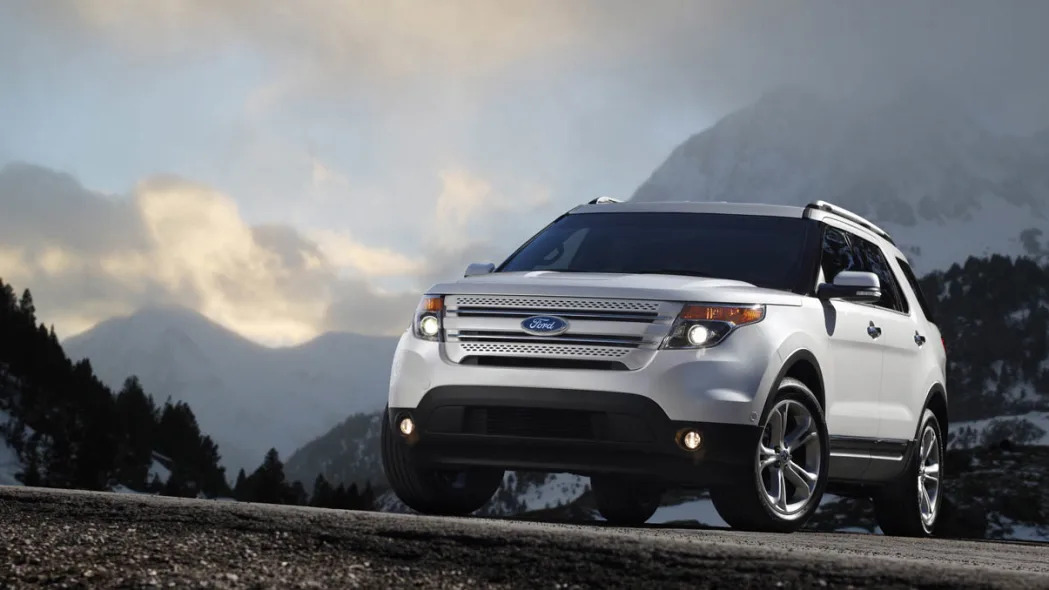

Sign in to post
Please sign in to leave a comment.
Continue